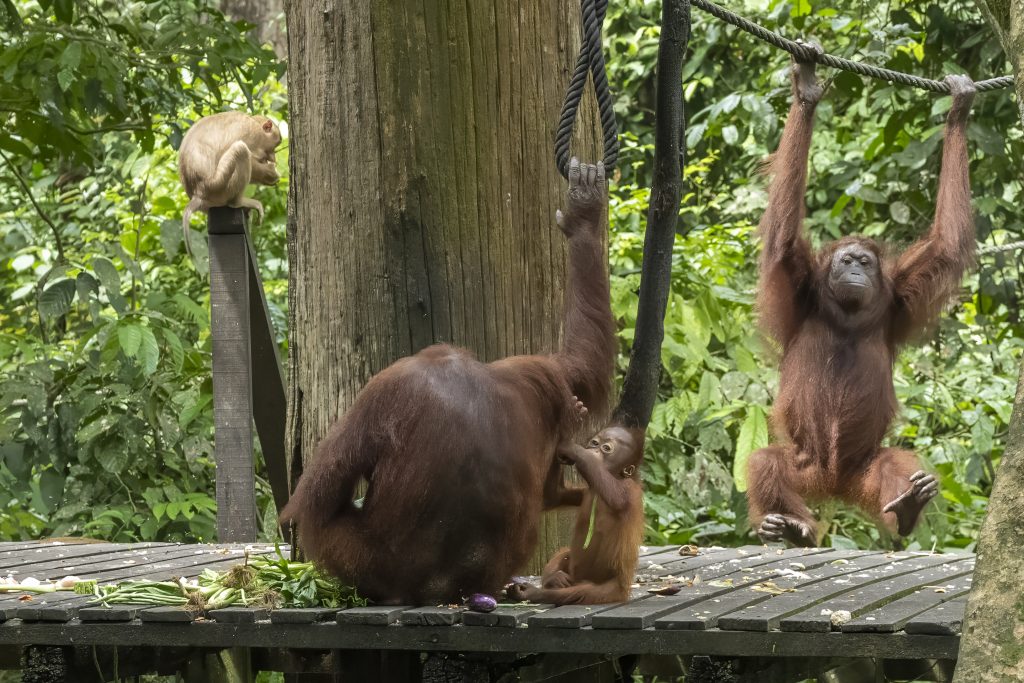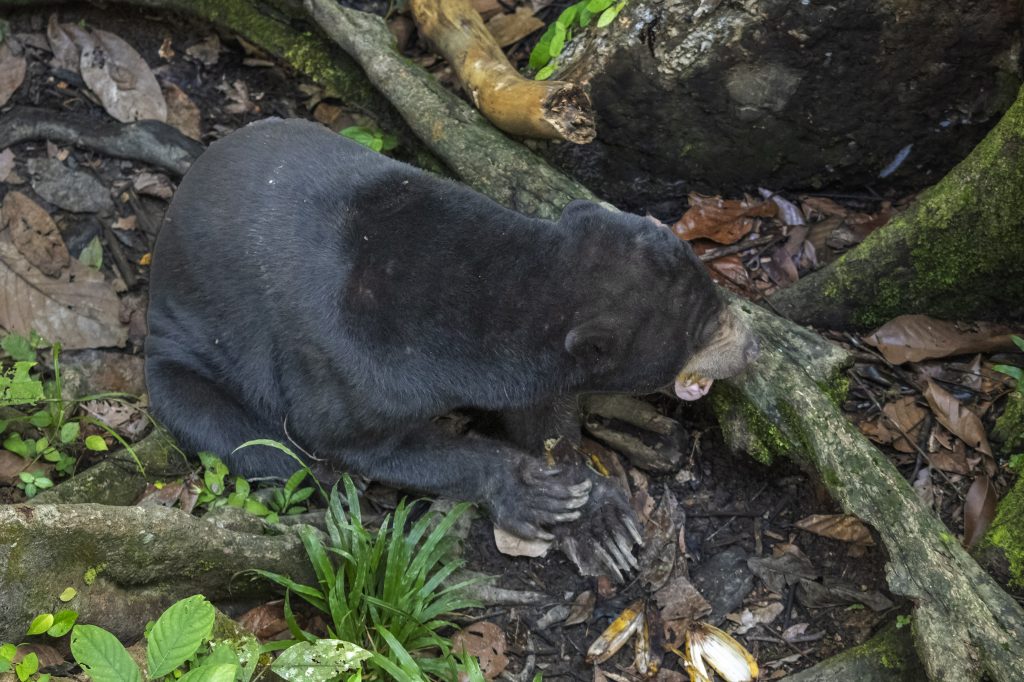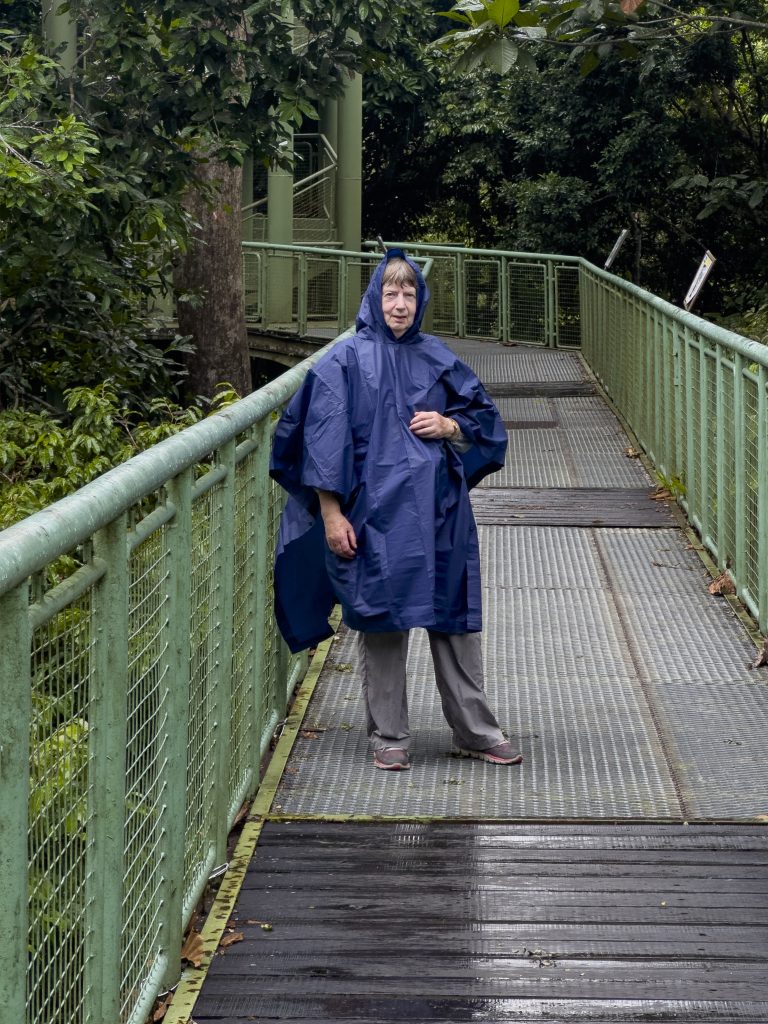
Leaving our house to drive to Adelaide airport, we were faced with a journey of about 24 hours that included three separate flights to start the first of two tours in Borneo. The first of these was a 10 day Trip a Deal tour in Sabah taking us from Sandakan on the east coast to Kota Kinabalu via the rainforest. However, two of these days were travelling, so the tour was really 8 days. The second was a 3 day Borneo Eco Tours visit back to the rainforest. We finished the trip with three further nights in Kota Kinabalu.
Arriving in Sandakan having had little sleep on the plane, we met up with the other 22 travellers in our group and were transported to our rather basic hotel with a sea view room for two nights. Wandering out for dinner that evening gave us our first introduction to the high humidity we would experience for the duration of our visit.
Sandakan
Located on the east coast of the northern tip of Borneo, Sandakan is a busy fishing port. During the war the British flattened the town leaving only three religious buildings standing. As a result, the town comprises mostly post war buildings. There was the inevitable rubbish, mainly plastic water bottles, lying around the streets and in the water (but not as much as India) and rather than dogs, cats wandered around the streets.

Feeling rested after a good night’s sleep our first day was packed with visits to the Orangutan Rehabilitation Centre, the Sun Bear Conservation Centre, the Rainforest Discovery Centre and POW memorial park.
The Orangutan Rehabilitation Centre
The Orangutan Rehabilitation Centre at Sepilok opened in 1964 as the first official orangutan rehabilitation project for orphaned baby orangutans rescued from logging sites, plantations, illegal hunting or kept as pets. Orangutans are now classified as endangered, but through the work of the centre and restrictions on habitat loss there is some optimism about the species future.
Because entry to the viewing areas prohibited bags of any description, I made the wrong decision on which lens to take, meaning that I was unable to get optically close to the animals. However, the first viewing area which was behind glass, gave us a great view of the young being fed and I was able to take some general shots. The second platform was in the open with the feeding area about 50 metres away – the only visitors were two adults and a baby.

The Sun Bear Conservation Centre

The Rainforest Discovery Centre
Our next stop at the Sun Bear Conservation Centre was disappointing as the bears, having recently been fed, were on the ground with viewing from an elevated platform.
These bears, the smallest in the world, continue to be threatened by forest degradation, illegal hunting for bear parts and poaching to obtain young cubs for pet trade. The bear’s bile has been scientifically proven to be medically beneficial for various internal conditions, collecting it has now been changed from killing the animals to humanely extracting it.
After lunch at a local resort, we visited the Rainforest Discovery Centre. This is essentially an elevated walkway with three tall towers where local birdlife and primates can be spotted. As we started our walk, we were treated to one of loudest claps of thunder, followed by heavy rain that didn’t stop until we left. As well as the humidity, the rain was another feature of the visit that we were to experience more than a few times.
Due to the weather conditions, we were disappointed not to see anything of interest.

POW Memorial Park
During WW2, the Japanese transported more than 2400, mainly Australian, prisoners of war from Singapore to Sandakan to build a runway in support their war effort. The Sandakan Memorial Park is located on the site of the POW camp and includes a commemoration of the start of what is known as the Death March – I will describe this in a later post.
Reading about the conditions that the POWs had to endure left us feeling very emotional, but this was balanced by the peacefulness of the park.
The coach was very quiet on the way back to the hotel with everyone lost in their own thoughts about what we had just experienced. Back at the hotel, we had a short rest, went out for dunner and packed our cases ready for an early departure. Unfortunately, I started feeling a sore throat during the night, so I dosed myself as much as possible to avoid a cough and cold.

Palm Oil
There has been much negative press about Palm Oil in the West and how it is destroying the native forest in Borneo and beyond. It was very interesting to hear the local perspective.
After the war the British started a significant timber business, clearing acres of forest in the process. On gaining independence in 1963, Borneo reduced this business and was left with the dilemma of what to do with the de-forested areas where the soil was of such poor quality as to not support traditional agriculture. The solution was the production of palm oil, a very sustainable and lucrative product for the local economy. From what we heard no forest was cleared for the planting of the palms.
Probiscis Monkeys
Unique to Borneo, the Probiscis Monkey is yet another endangered species. On our way to the rainforest lodge, we visited the Labuk Bay sanctuary to witness the monkeys being fed. Unfortunately, they did not appear at the first platform so we were hastily relocated to another feeding place. After an extended wait they eventually came in, much to our enjoyment.

Interestingly it is only the alpha male who has the extended nose which they use for various purposes including warning of intruding predators and attracting mates. Typical of alpha males, this photo shows his permanent erection – another symbol of his status (and readiness to mate).
We were also treated to our first Hornbill sighting – the Oriental Pied Hornbill – which settled on an old tree stump close to where we were standing.

The Rainforest
Having waited to see the monkeys, our departure for lunch and the rainforest lodge on the Kinabatangan River were delayed. With our first river safari due to depart at 3.30, we hardly had time to check in and quickly change. Our experience at the lodge will be the subject of my next instalment.
